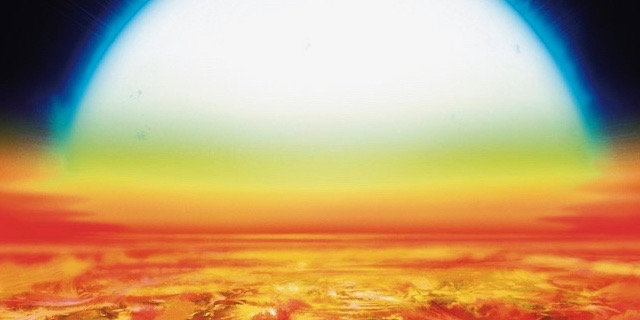Examining the atmospheres and climate of exoplanets

After being able to measure the masses and the diameters of exoplanets, using the information to deduce what materials they have formed from, astronomers now seek to detect the chemical composition of their atmospheres if they possess one. For several years, atmosphere detection announcements have been in the news before being questioned and recently proven. NCCR members are at the forefront of research in the field, having detected sodium, iron and helium, while researchers from other institutes have done the same with water vapour.
All these highlights, however spectacular they may be, have been made on fairly large planets, the smallest of which being the size of Neptune. Research and analysis of exoplanetary atmospheres is now one of the three main areas of research of the NCCR PlanetS, one of the aims of which is to detect and analyse the atmospheres of small rocky planets like Earth. Is it possible to detect atmospheres and even try to find out what they are made of? Alone the detection of exoplanets requires enormous resources (the ESPRESSO spectrograph on the VLT in Chile or the CHEOPS, KEPLER and TESS satellites). In order to achieve this challenging measurement, two techniques are currently favoured by astronomers: transmission spectroscopy and secondary eclipse.
Transmission spectroscopy
When a planet passes in front of its star (transit) it causes a mini eclipse which has the effect of provoking a small decrease in the luminosity of the star, this decrease depends on the radius of the planet, the larger the planet the greater the decrease will be. If by chance the transiting planet has an atmosphere, it will appear a little larger (the drop in light will be greater) if we look at it at a wavelength that corresponds to the element contained in the atmosphere.
“It is an effective technique but it requires a very high degree of precision and its results are not always easy to interpret” explains Christophe Lovis, member of PlanetS, “on large planets like the hot Jupiters, the difference in depth is around 10-3 on a transit whose depth is already around 10-2“. These are therefore measurements that, although disturbed by the Earth’s atmosphere and its chemical elements, can be made on the ground with high-resolution spectrographs such as HARPS or ESPRESSO. This is one of the strengths of PlanetS researchers, high-resolution spectroscopy makes it possible to bypass the telluric (effects caused by Earth’s atmosphere) problem. Things will become even more complicated when looking for oxygen in Earth-type exoplanet atmospheres (if any are found), indeed the difference in depth is about 10-6 for the Earth-Sun pair! “Impossible to achieve with current instruments” says Christophe Lovis with a sigh, “but if we look at much smaller M dwarf stars like TRAPPIST-1, the ratio rises to 10-5 and there it may be possible with the JWST or with the new infrared spectrographs like NIRPS or HIRES on the ELT”.
Secondary eclipse
The other technique, that of the secondary eclipse, consists in subtracting the spectrum of the star and the planet from the one of the star alone (when the planet passes behind the star). A technique that depends on wavelength, a hot object orbiting a cold star will be more easily analysed since the difference in spectrum level is less significant. Here too, we must observe from space with devices such as the HST or the American satellite SPITZER, a technique that remains unusable for the time being for small planets like Earth. However, with ground based instruments of high spectral resolution (HARPS) it is possible to deduce from the analysis of the shape of lines such as those of sodium, the rotation and speed of hot Jupiter winds.
“If we rely a lot on ESPRESSO and CHEOPS to study exoplanets” says Christophe Lovis, “we are not neglecting our solar system”. Indeed, Domain 3 of PlanetS relies on the images of Mars taken by CaSSIS, the University of Bern camera installed on the European TGO probe around Mars and in the near future on BELA (a laser altimeter) left with BepiColombo, also from the University of Bern which should arrive at Mercury in 2026.
Instruments for the ELT
Astronomers in PlanetS’ Domain 3 are looking even further ahead, including the Extremely Large Telescope (ELT) in Chile and a future spectrograph specially designed for the 40m diameter giant mirror telescope. HIRES, that’s its name, is placed under the direction of Italy with the University of Geneva as its main partner and with the collaboration of the University of Bern. “Phase A of the instrument’s development is complete, we have developed the concept of thermal control and optical design and the Bernese have been working on the calibration unit,” explains Christophe Lovis. For Phase B, the preliminary design, the astronomers had to present the project to the FLARE commission of the National Research Fund in early February.
“This is a kind of competition for instrument development that includes the demands of particle physics and astrophysics. “Astronomers don’t start as favorite in this kind of competition, it’s difficult to compete with institutes like CERN for example,” says Christophe Lovis, “but with the ESO and ELT, we certainly have more weight now”. The ELT is scheduled for 2025 and HIRES for 2028, however, there is another instrument, METIS, which was also presented to the FLARE Committee by Sascha Quanz of PlanetS. METIS is an infrared imaging spectrograph for direct imaging designed with the participation of ETH Zurich. “What would be fantastic,” Christophe Lovis enthuses, “is that both projects should be accepted, so we could dream of bringing the two instruments together to obtain spectrum and image,” but that’s really music of the future. (PB)
PlanetS Domain 3, see http://nccr-planets.ch/research/phase2/
http://nccr-planets.ch/blog/2018/12/06/a-planet-inflated-like-a-balloon/
http://nccr-planets.ch/blog/2018/08/16/iron-and-titanium-in-the-atmosphere-of-an-exoplanet/
Categories: External Newsletter, News, Uncategorized



